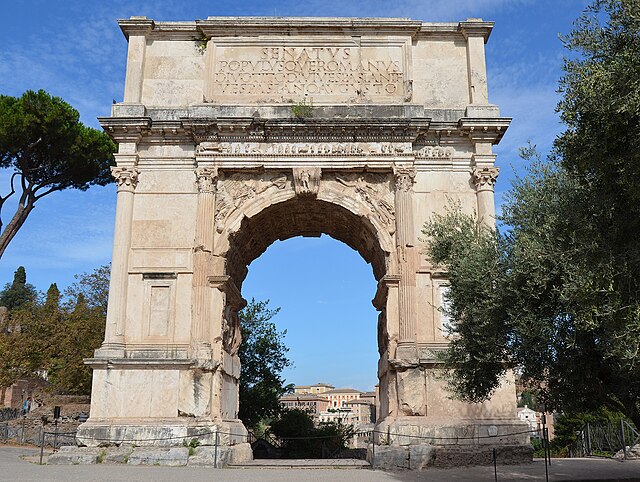The Triumphal Arch of Orange is a triumphal arch located in the town of Orange, southeast France. There is debate about when the arch was built, but current research that accepts the inscription as evidence favours a date during the reign of emperor Augustus. It was built on the former via Agrippa to honor the veterans of the Gallic Wars and Legio II Augusta. It was later reconstructed by emperor Tiberius to celebrate the victories of deceased general Germanicus over the German tribes in Rhineland. The arch contains an inscription dedicated to emperor Tiberius in AD 27. Along with the Roman Theatre of Orange, the Triumphal Arch was inscribed on the UNESCO World Heritage List in 1981 because of its exceptional preservation.
Monumental Arch of Orange
Triumphal Arc in 1842.
Front of Arch
Top panel
A triumphal arch is a free-standing monumental structure in the shape of an archway with one or more arched passageways, often designed to span a road, and usually standing alone, unconnected to other buildings. In its simplest form, a triumphal arch consists of two massive piers connected by an arch, typically crowned with a flat entablature or attic on which a statue might be mounted or which bears commemorative inscriptions. The main structure is often decorated with carvings, sculpted reliefs, and dedications. More elaborate triumphal arches may have multiple archways, or in a tetrapylon, passages leading in four directions.
The Triumphal Arch of Orange in Orange, France, the oldest surviving triple-arched Roman triumphal arch, probably built during the reign of Emperor Augustus (27 BC–14 AD), later reconstructed by emperor Tiberius (c. 20–27 AD)
The Arc de Triomphe, Paris, begun by Napoleon in 1806
The Arch of Titus in Rome, an early Roman imperial triumphal arch with a single archway, built c. 81 AD by Emperor Domitian to commemorate his brother Titus's victory together with their father, Vespasian, over the Jewish rebellion in Judaea
The Arch of Septimius Severus at Leptis Magna, Libya, a four-arched arcus quadrifrons, built c. 203 AD








